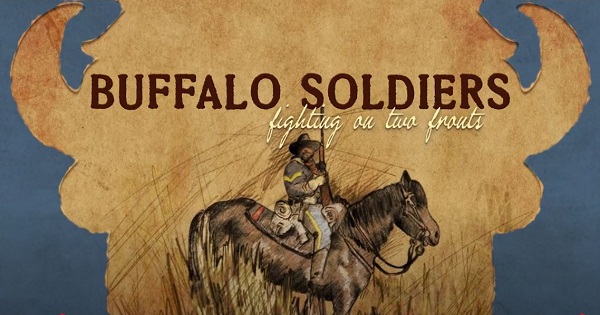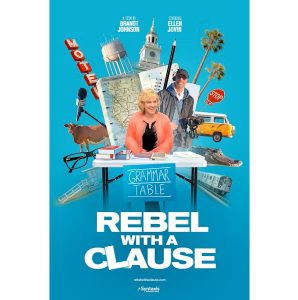Eugene celebrates Buffalo Soldiers during Black History Month
8 min read
Destinee Thompson didn’t know much about the Buffalo Soldiers before she attended a special Black History Month film screening at the WOW Hall.
Destinee: Actually, I had no idea before the film who the Buffalo Soldiers were. I’ve never been like a really big history type of person.
[00:00:17] Presenter: It turns out, before he made the film, director Dru Holley didn’t know very much about the Buffalo Soldiers either. Destinee Thompson:
[00:00:26] Destinee: His inspiration for the film was actually through his daughter. He went to a festival for Juneteenth in Seattle, Washington and so he was at this festival and his daughter was like, ‘Oh, look, dad, there’s these soldiers and they’re on these horses, like, who are they?’
[00:00:44] And he said he couldn’t answer her at that time, but he felt like that was something he should know as part of his history and who he was. And he’s like, ‘You know, I want to be able to educate my daughter and the people on this,’ and so that’s what his inspiration was from the film.
[00:01:02] They were just these amazing Black soldiers that were formed in 1866.
[00:01:10] They fought in the Indian Wars and the Spanish-American War, and they were already fighting before Theodore Roosevelt and the Rough Riders got there, and it was actually because of these Buffalo Soldiers that they were able to actually win the war because the work that they did first allowed space for the Rough Riders to come in.
[00:01:32] Not only were they soldiers, but when they weren’t fighting in wars, they were a big part of building the railroads and actually so much so, where they were stationed and they were building all of these things, it actually was like the first starts of Black communities within these white settlements during that time.
[00:01:53] And so they were able to be the first ones to build connection within the communities, like, we’re a big part of this and be able to showcase Black excellence and Black families.
[00:02:05] Presenter: We asked about the name. How did they come to be called Buffalo Soldiers? Destinee Thompson:
[00:02:11] Destinee: The Plains Indians, they described them as, like the woolly hair on the top of the buffalo, because of their woolly hair on the top of their heads. And their fighting style was very savage, like the buffaloes, so I think it’s really cool that they saw them as fighters and really strong like the buffalo.
[00:02:34] And then another theory was when they invaded, during the Indian Plains War, when they took over the land, there was a lot of buffalo coats. And so there was a photograph of the Buffalo Soldiers in these woolly coats. And so they figured too that they might have gotten their name from that as well.
[00:02:55] They were a big piece of history that were basically excluded because at that time, you know, Black people weren’t considered hardly even human.
[00:03:05] Presenter: The subtitle for the film is ‘Fighting on Two Fronts,’ which refers to the hostility they faced from whites.
[00:03:12] Destinee: The ‘Fighting on Two Fronts’ was actually the biggest part of the film because it highlights that, back at home, they were fighting against segregation and the Jim Crow laws, and also their commanding officers. They had to prove themselves within the army, and then also fight the enemy that the commanding officers were saying that they had to fight against.
[00:03:35] It just really shows their strength and their character as far as, ‘I’m going to still do this anyway,’ for whatever their reasons were as far as getting education and feeling good about themselves as men in war. ‘We’re fighting, you know, within our army and then we’re also fighting on the outside as well,’ so that’s why it’s fighting on two fronts.
[00:03:59] The movie was very well put together, and talked about, really touched on a lot of things even behind the whole history of that.
[00:04:08] Presenter: The director was asked about highlighting the heroism of the Buffalo Soldiers, even as they were being deployed against Native Americans in support of white settlement. Destinee Thompson:
[00:04:20] Destinee: He answered that he portrayed the life of the Indians, he portrayed their side of the story and they were excellent fighters, but he was saying also, when you sign up for war, you don’t really know who you’re going to be fighting. They didn’t see them as, ‘Oh, these are people who look just like us,’ you know. It was more like, ‘These are the enemy’ in their eyes, vice versa with the Indians as well, they just saw them as the enemy.
[00:04:50] They both had missions and what they were trying to do. And a lot of tragedy came from that, but at the same time, there was a lot of positive things that also came from that. And so it’s just highlighting both of those sides of the coin.
[00:05:04] Presenter: The Buffalo Soldiers would go on to protect the lands that became Yosemite and Sequoia national parks, and participate in every subsequent U.S. war, including WWI, WWII, and the Korean War. In 1948, the United States would eventually end its practice of segregating Black and white soldiers. Destinee Thompson:
[00:05:25] Destinee: It got to the point where now we are living in a time where now segregation within the military is not there, and Black people are able to fight in an integrated sense with their white counterparts.
[00:05:38] One particular soldier that was portrayed. in the film, Charles Young, was very, involved in the military and it was, it was really close to him. And actually his father was a part of the United States Colored Troops before they organized into the Buffalo Soldiers.
[00:05:54] And actually his mother was also a big important part of that too, because she was one of the slaves that was able to—one of the rare slaves that was able to, you know, find a way to educate herself within slavery and so he Charles Young really got that kind of extra start.
[00:06:13] And so it was a really big, important part of like his background. And so, you know, as he was rising in ranks and educating himself he had got to a point where he was being recommended over the whole division, and so at this time, the white commanding officers, they were like, ‘No, we don’t want that.’ And so they tried to put all these barriers in place and then still, you know, he overcame them.
[00:06:40] So, just really highlights how they were just really courageous and they didn’t let anything hold them back.
[00:06:47] Presenter: The director is touring with the film to multiple cities. Destinee Thompson:
[00:06:52] Destinee: As we’re in February, it’s Black History Month and so I think that’s his goal. Dru is going around to multiple cities to try to highlight this film. And I think it’s a really, really important time for that because of the current political climate and you see a lot of information being brought to the forefront that was hidden from our past.
[00:07:19] And one of the guys in that legacy group in Seattle for the Buffalo Soldiers, he said it’s really important that as for him, it was really important as a Black man to know his history and where he comes from and it enables and inspires you to be something more, you know.
[00:07:39] It really sets a broader expansion within your mind of what’s possible and what you’re capable of. And so, I’m just really excited to see more and more of this and more films to come.
[00:07:52] So this film in particular really inspired Dru Holley to produce more films like this. And actually this film was a big hit for him because he’s done over like 200 different documentaries and films, but this one was big, PBS got on with it, you know, and so I think we’re going to have more to come, and not just with Dru, but just all around. I think all of our people are being able to come out and, express, ‘Hey, there’s two sides of everything and we were involved too.’
[00:08:28] The movie actually inspired me to dig deeper into the history. And like I said, I’m not a big history person, you know, but I do enjoy storytelling. I do enjoy a good story. And if the history is involved in it, another part that can highlight another part of me as a Black woman, you know, that’s really big for me. And so I started delving deeper into history and like, okay, where was the beginning of all of this, you know?
[00:08:55] And so that’s when I went back into the U.S. Colored Troops where it sounds like Black people were always involved in the military, you know, they were always involved from the very beginning.
[00:09:05] Presenter: Historians believe they made up between 10% and 15% of Gen. George Washington’s Continental Army during the American Revolution. Destinee Thompson:
[00:09:15] Destinee: When the military was first organized back in 1775, there were a lot of troops that were of color, about 13% of the military that were of color and about 100 years later, they built into the Buffalo Soldiers who were in the 9th and 10th Calvary, which were the soldiers who rode on horses, and then they were also in the 24th and 25th Infantry.
[00:09:46] You know, they saw an opportunity, I feel, as like, ‘Okay, this is an opportunity to show who we are,’ which, you know, kind of sucks sometimes. We live in a country where you can’t just be as a Black person, like, you have to prove yourself in a sense. But they didn’t let that kind of mentality hold them back. They saw an opportunity and they went for it. And I think that is also a big testament to how we operate in choosing courage over fear of things.
[00:10:19] I think people are kind of waking up to like, ‘Okay, we are all in this together,’ you know, and so I’m just taking the inspiration from the Buffalo Soldiers and using courage and just doing it.
[00:10:34] Cedric: That’s Destinee Thompson sharing her experience, as producer and director Dru Holley brings his film Buffalo Soldiers: Fighting on Two Fronts to Eugene for Black History Month. You can learn more about the film online at BuffaloSoldiersMovie.com.






